Sid Meier's Alpha Centauri - UN Peacekeepers 5CC
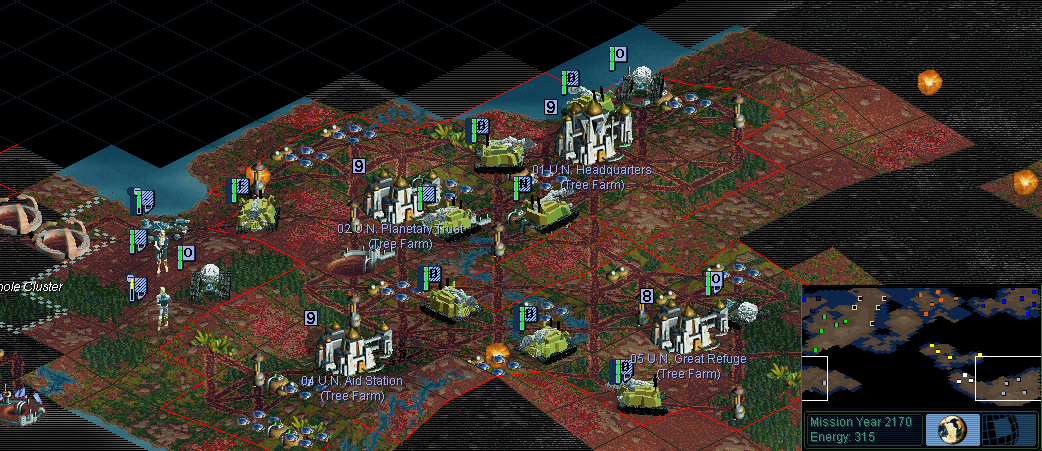
Here's the aftermath of the University war. I captured and disbanded their three closest bases. I decided not to go for more, because the University presently researched one tech (High Energy Chemistry) and started another (Advanced Subatomic Theory) that I didn't have but didn't need for a while, so I wouldn't mind letting them complete that for me to steal later. I didn't make peace but stayed at vendetta, so I could kill off any incoming colony pods to keep the area clear of bases trying to steal tiles from me. Mostly the University just sent probes that I easily whacked. I also bribed one more unit, another gatling rover; it was actually cheaper to get units by stealing University bribe bait than to build my own!
Back to domestic development. My next goal was to boom all the bases up to full size, with hab complexes. The only sensible way to get the food would be tree farms. And those should come first, since they also give an economic multiplier, while as I keep stressing a hab complex doesn't do anything if you don't have the food to fully boom. This is worth chronicling turn by turn to show exactly how I went about it:
Year 2170: Each of the tree farms was about halfway done, and now I had enough money to rush them all, so I did. Each invoked the Stockpile Energy bug as well for about an extra ten credits per base.
2171: During upkeep processing, each base completes the tree farm and starts its hab complex. Now I need to configure the Golden Ages to start this turn, then rush the hab complexes next turn, so that on the following turn's upkeep each base will boom.
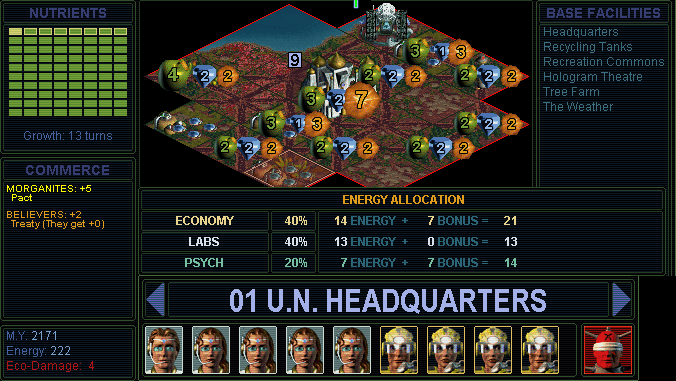
Kind of amazingly, the Golden Ages only took 20% psych slider. That's without even any borehole energy yet, although the commerce pact with Morgan is contributing. The Golden Ages were a low enough cost that I decided to just go with that for the boom rather than building creches in the three bases that still lacked them. Each base had +100% psych multiplier from the total of the hologram theater and tree farm.
2172: During upkeep processing, each Golden Age starts. During the turn, I cash rush all five hab complexes -- after switching to Planned economics. I need the growth modifier for booming, and can also take advantage of the industry discount at the same time.
2173: During upkeep processing, each base completed its hab complex. And with the golden age growth modifier already in effect from the previous turn, now everything boomed and would continue to do so.
I also took advantage of a particular backdoor economy boost here. The Golden Age gives +1 Economy rating to a base as well as the +2 Growth. Usually that means little, just 1 or 2 energy... but with Wealth, that makes for a total of +2 Economy rating, so the base can get the +1 energy per square even without Free Market! This is a precarious position: the Golden Age's own energy sustains itself; if such a base drops out of GA then it will lose the psych energy it would need to maintain it. (To recover and restart the GA would mean to raise the psych slider.)
The bases continued to boom for several turns as planned. As always, I juggled food micromanagement with terraforming improvements and a few supply crawlers to keep every base at +2 food every turn. I was able to keep the Golden Ages going all the way up to size 15 by eventually going to 30% psych slider.
The bases finally built network nodes during the boom, then research hospitals. When the boom was finished, I switched out of Planned back to Free Market -- but not before making use of the industry discount one more time by rushing three research hospitals on the last turn of Planned.

Here we are at the conclusion of the big boom. (The downward glitch in the dominance graph was disbanding the conquered University bases.) Not every base quite made it all the way to the full max size 16. UN HQ and Planetary Trust stalled out for lack of food, particularly when eco-damage fungus burst on a nutrient bonus tile, but I also inadvertently sabotaged my own food a little bit by building boreholes. With those bases stalled, it wasn't worth keeping the psych slider up for a golden age for just the one base of Aid Station. Finally, Great Refuge was one size behind simply because it had started out that way, and booming just one base also wasn't worth staying in Planned economics for an extra turn.
You can also see my bases building empath rovers. I actually built multiple rounds of them after losing quite a few. A rover would leave its base to attack a worm, and win but drop under 50% health so it no longer had 2 moves to get back to safety, so it was left exposed for another worm to kill. Another advantage of a denser build: each rover can play zone-defense, covering several bases within its movement range; but here the more sparse bases each had to have their own rovers on hand. I also lost a few formers to worm attacks, but decided I'd rather replace them with super formers at Adv Ecological Engineering tech.

My crater base was the only one that actually made it to size 16... but damn if that isn't the most beautiful base I've ever seen. What happened here was that each of the formers had spread out in different directions from the base, so they were never stacked up to build boreholes, so I didn't and kept doing all forest instead. I almost didn't even want to spoil that beauty by sticking a supply crawler on it... so I didn't! (The crawler was to put into the Merchant Exchange at the HQ anyway.)
That picture shows 10% psych slider to maintain happiness. With some fiddling, I actually discovered I could get more labs even with a higher psych slider at 20%, by switching doctors to labs specialists instead. I was all excited to work out the math of how that was happening, it must be an effect related to my discussions of specialist economics in Civ 4. Then I realized there's nothing tricky at all, it's just quantity; a specialist can yield 2 psych or 3 labs, so it's better to get the labs in greater quantity from specialists and psych from the slider instead. (Multipliers could affect this equivalency, but at the moment that was moot, each base had both +100% psych and +100% labs.)
This moment should be the peak of the power curve for this game relative to the others. I completed vertical growth, both the booming itself and the science multipliers, significantly sooner than the other games. Now back in Free Market, this game was at 274 labs/turn, compared to about 100 for the Hive at the same date... but behind Morgan at 414 labs and about to blow the lid off with the Cloning Vats. All along, this game had been just about halfway between the Hive and Morgan games in terms of economic productivity. Nothing can keep up with the kind of ICS and PTS abuse that Morgan displayed, but we'll see what we can do here.
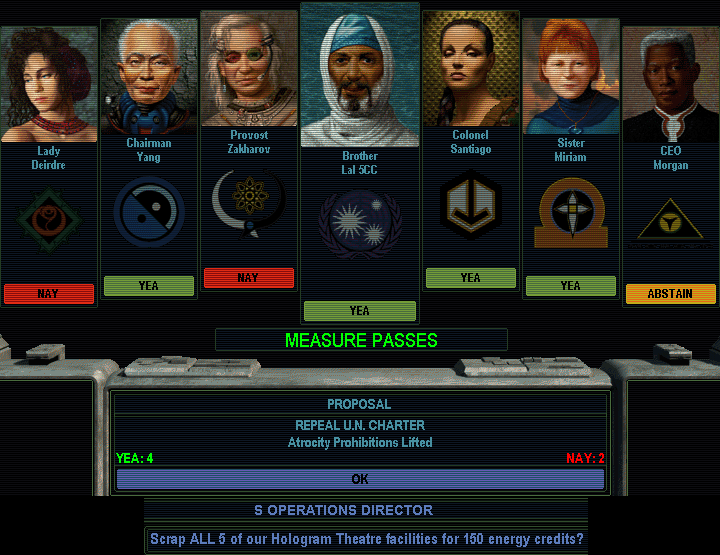
Next move: as in the Morgan game, repeal the UN charter and nerve staple everything. Yes, even as the humanitarian peacekeepers of the United Nations. I'm not role-playing here. This is the strongest drone control of all, so I'm doing it. That was a significant economic boost, now able to dump the psych slider and set all specialists for labs. I hadn't done this sooner since stapling does have one downside, it cancels out talents as well as drones which makes Golden Age impossible, so I held off until I finished booming. (It quite likely would have been better to staple earlier and simply build the creches to boom instead of via the golden ages, but I didn't think along that line.) And then I could also sell the Hologram Theater facilities for cash and to save the expensive 3/turn upkeep cost.
Presently my tech goal was Fusion Power, aided greatly by stealing my way through or past about six of its ten prerequisites. I researched Doctrine Loyalty (Hive wouldn't trade it) - Intellectual Integrity - Cyberethics - Pre-Sentient Algorithms - Fusion Power. Cyberethics enabled the Knowledge SE choice, which I adopted right away; this game unlike Morgan had no attachment to Wealth, and the PKs could also quite use the efficiency of Knowledge. I rushed all the fusion labs with 1000 credits earned from harvesting eco-damage worms.
As usual, that brought me to the breakpoint where Green became the best choice for economics. At maximum +4 Efficiency with Green (and Knowledge's +1 also necessary to counteract the PK's faction penalty), I could now go to 100% labs slider with no unbalancing penalty. This configuration would yield more labs, outweighing Free Market's raw yield. Being out of Free Market also let me apply the second and third rounds of nerve stapling when necessary.
Past Fusion Power came Advanced Ecological Engineering. This enables double-speed formers and soil enricher improvements (another +1 food on top of a farm, which actually comes to +2 when under a condensor's x1.5 yield as well.) I didn't make any use of this tech in the Hive and Morgan games, where it had come quite a bit later after first going to the Cloning Vats and orbital satellites. But here it came early enough to be worth building a decent amount of super formers (still not really worth upgrading old ones at 30 credits each), which I'd shortly need. And soil enrichers let me shift a few more population off farms into specialists.

But now I had to handle the biggest problem for building big bases: eco-damage. Going vertical is economically multiplicative, but there is no multiplicative reduction for eco-damage. Each fungal pop or ecological facility only linearly raises the threshold, which can't be very much at all with only five bases! The Hive game ultimately dealt with eco-damage by building 40 tree farms, an option I wouldn't have here. I know how to fight the worms with empath rovers and counteract rising seas, as chronicled in the Hive game. But the downside was stalling out on terraformer activity, as they kept having to repair eco-damage fungus pops on food tiles rather than making more boreholes. I had to actually behave here, and keep bases to about two boreholes each. I could live with modest mineral output of ~25 per base, as they had already built all their important facilities.
The advantage of going vertical is that each multiplier facility can get a big baseline of input, but you also need to keep increasing that baseline. Now I couldn't continue to do that with population growth or boreholes. The big swell in the other games was energy satellites, but those aren't so hot when powering 5 bases instead of 40 or 70. There's a clue in the previous overview for what I'm going to do next.

The clue was the roads out in the open land, to prepare for something I didn't do in the other games: the energy-park of crawlers on a matrix of solar collectors and echelon mirrors. This looks really cool of course. But I seldom do it compared to just building more bases to work forest and boreholes instead. But if a variant rule limits the count of bases, then this is how to use available land to continue to ramp up. This is the other reason I stretched out so far to the crater base early on, to surround and reserve this land for the energy park later. The energy park also let me make use of the Drill Aquifer terraforming option, which creates a river; usually I don't do this much because the rivers just fall down boreholes, but here I got a few that stretched for a nice distance across the land.
Although it actually turned out that the energy park would ramp up rather slower than I'd expected. Building the supply crawlers is a significant cost. It's roughly akin to growing a city size for 30 minerals, ignoring food both ways (neither produced by nor required to work the crawled tile.) That's... not really great in the cost department compared to population-booming. The terraforming labor is also quite significant, even with super formers; you also need to clear fungus, build roads, and raise the terrain to high altitude for solar collection. (Don't raise every tile to max; what you want to do is judiciously raise selected tiles to 3000m so that each job also pulls up many surrounding tiles to 2000m.) The support for all those formers (as much as 15 per base!) weighed heavily on building the crawlers too. Finally, it even took quite a while just to get most of the existing formers moved over to this area, which didn't really happen until after the tech for mag-tubes.
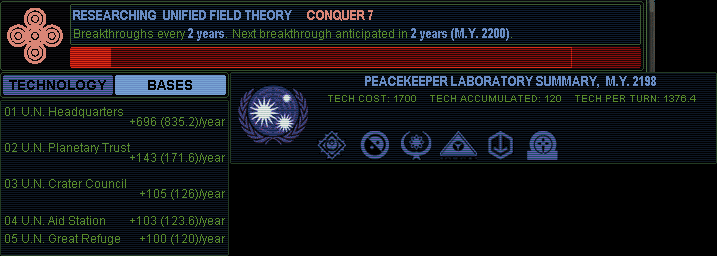
What finally did ramp up bigtime was the labs-doubling secret projects, the Supercollider and Theory of Everything. These famously stack up multiplicatively on top of each other and everything else. This picture is after Applied Relativity to enable the first of those. I might have gone for that sooner, before Fusion Power; but the University was researching its prerequisite (Adv Subatomic Theory) so I waited until I could steal that.
However, notice the problems going on here, in managing the overflow that happens with large amounts of labs. During production processing, each base in order applies its labs, but any more than needed to finish the current tech target does not overflow but goes to waste. In this picture, I can't complete Unified Field Theory this turn... so on the following turn, UN Headquarters will overkill with its 800+ labs production against only the 200 that will be required.
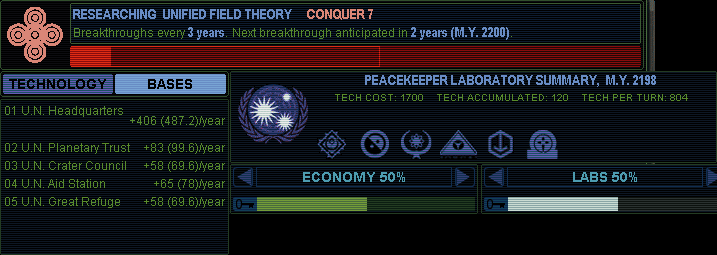
The only useful outlet for the would-be overflow was to put it into energy instead, via the slider. This is the correct setup for this turn: bring my total labs up to 800 shy of the tech, because that is what UN Headquarters will produce back at 100% slider on the following turn. I didn't really mind diverting some juice into energy here. I didn't have much money production, since each base only had about two or three fusion engineer specialists, unlike the Hive and Morgan games that often had 8+ per base thanks to food satellites that I didn't have yet here. In fact I directly needed this money for the crawler upgrades for the second labs doubler SP.

And here's the overflow problem after also adding the Theory of Everything to complete the quadrupled-labs super-science-city in my HQ. Now UN Headquarters all by itself produces enough labs for a tech every turn. That's great! ... except that renders the labs production from every other base unusable. No matter how much science the four bases produce, it's useless because they won't complete the next tech but then HQ will on the next turn. There is a brick wall limit of one tech per turn that I can't surpass until the other four bases can add up to enough to complete another tech between them. Again, the only way to avoid wasting a ton of labs was to divert some into energy instead via the slider. Each turn, I had to micromanage the slider and specialist arrangements until I'd exactly complete one tech but no more. But even despite that lost overflow, this game was still ahead of the Hive in labs production at the same date.